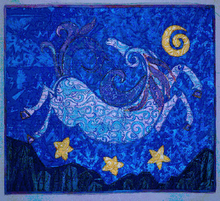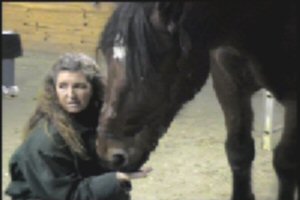Received this note from "Andy" today and thought he put down in words something that I also advocate. I always have my students do a "preflight" test before getting on their horses for a ride.
"You ride what you lead."
Figured it would be helpful to many here.
------------------------------------------------------
Dear Gwen,
My friend and horse trainer Jim Rea
is big on making sure your horse says 'Yes'
to letting you ride him for the day.
How do you know your horse is saying
'Yes!'?
Essentially, your horse is saying yes
when he says he trusts you, that he's not feelin' spooky, and that you can stop him if you need to.
Now the next question is this.
How do you know he says he trusts you, he's not feelin' spooky, and that you can stop him?
Ahhh...that's the part we gotta know.
Although I can't explain it in detail in an email (my fingers would lock up from typing so much)...I'll give you a good summary.
First, bond with the horse when you first greet him for the day. Be sure you bond in a way that he knows you're the leader.
Second, do some take and give. Get your horse to yield in a couple quick exercises to make sure he willingly yields.
Third, use the intimacy technique. Basically, you will touch the horse in places that would normally be hard to do because being a prey animal makes him nervous.
But taught and done correctly, this is good test to see if you're in safe mode for riding. In other words, if your horse lets you handle him in this manner, he's saying he trusts you.
Fourth, you'll have him do a little dance. It's not 'really' a dance. But it kinda looks like it when you have him do this simple lunge.
After a couple easy circles, pull the lead rope to create a One-Rein Stop.
When doing it, you disengage his hindquarters and look for him to cross the inside rear leg in front of the outside leg as he disengages.
Once disengaged, ask for another bend of his neck in the One-Rein Stop fashion. When he gives, loop the rope around his butt. Gently pull and the pressure on his rear end creates a little discomfort. He'll move out and away from that.
Disengage hindquarters again. Ask for another neck bend.
Done.
Fifth, try a few things to check his sensitivity meter such as slapping a rope on the side of a metal wall while you and the horse are by it. (If you don't have a metal wall, do something that would pique his fear level and check his reaction - don't over do this)
See if he's extra skittish, fairly calm,...?
If he's pretty calm, you're doin' good. If not, it's a sign to you to be on your guard but not so much that your horse can read your body language as fear. That'll make him fearful.
Lastly, get in the saddle. Flex his neck to both sides. If does it well, you're in pretty good shape. If he doesn't, keep workin' at it some.
If he's never done it well, you need to work with him and get him doing it with very little pressure. ( four to six ounces tops)
After flexing the neck, have him step out and turn him to a direction you want to go. Check his turning and stopping.
Do it in a walk.
If he doesn't do it well in the walk he'll have even more trouble when moving faster - thus, beware.
Why do all this?
It tells you what you can more or less expect when you go for a ride.
It sounds like a lot to do, but it really doesn't take all that long and it's well worth the effort.
Besides, it'll show you where you need to work on your horse...if you need to, that is.
Jim Rea who showed me this is one of our pro trainers from Super Stars of Horse Training.
In his DVD, you'll see a very detailed instruction on how to do this. Click the following to know more:
http://www.SuperStarsOfHorseTraining.com/Rea
Adios until manana.
Sincerely,
Andy Curry
www.horsetrainingandtips.com
www.SuperStarsOfHorseTraining.com
Subscribe to:
Post Comments (Atom)



No comments:
Post a Comment